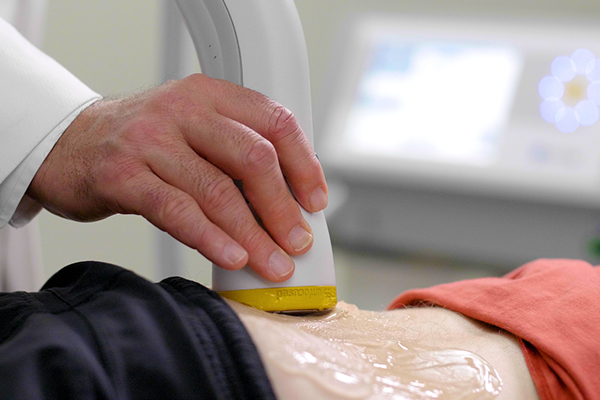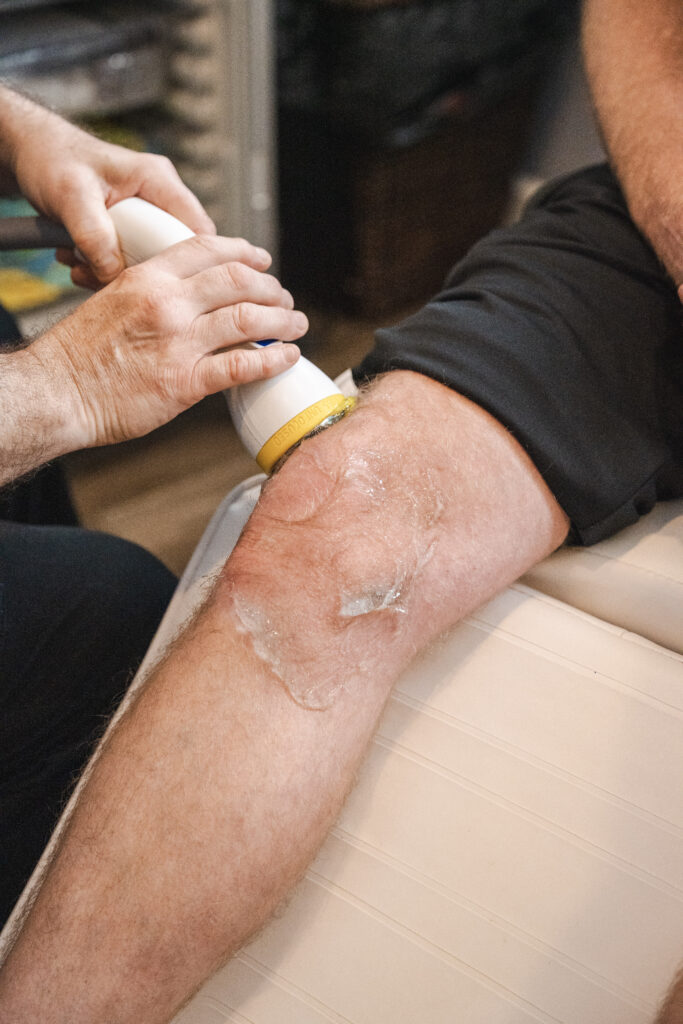Ultrasound therapy is a non-invasive technique designed to alleviate chronic pain and hasten healing. Unlike diagnostic ultrasounds used for imaging, this therapy uses ultrasound waves to generate deep heat in body tissues. This heat promotes tissue elasticity, improves circulation, eases pain, and enhances natural healing.
Breaking down the foundational mechanics of Ultrasound Therapy, we identify:
- Thermal Effects: The sound waves, upon contact with the body’s internal structures, produce heat. This localized heating in tissues can enhance extensibility, increase blood circulation, reduce pain, and accelerate the healing process.
- Mechanical Effects: The oscillations from these sound waves trigger vibrations within the tissues. Such mechanical vibrations can foster cellular activity, augment local blood flow, and curtail edema or swelling in the affected regions.
- Cavitation: During the therapy, microbubbles form in the tissues, a phenomenon known as cavitation. These gas-filled bubbles can positively impact cellular functions and play a part in tissue repair.
Therapeutic Ultrasound typically oscillates between 800kHz to 2MHz. These waves consist of steady periodic oscillations with a narrow bandwidth, distinguishing them from other forms of wave therapy.
What Do Shockwave Therapy & Ultrasound Therapy Treat?
Both Shockwave and Ultrasound Therapies have been widely used to treat an array of medical conditions, primarily those linked with pain and inflammation. They are known for their ability to accelerate healing and offer pain relief. While both therapies are non-invasive and harness the power of waves to treat ailments, their area of specialty varies.
Shockwave Therapy has proven to be a game-changer for many conditions, particularly for those who have proven stubborn to traditional treatments. For instance, it has shown marked efficacy in treating conditions like plantar fasciitis and tennis elbow. One study highlighted shockwave therapy’s superiority over ultrasound therapy, noting its pronounced impact on pain reduction during activity, enhanced efficacy success rate, fewer activity limitations, and elevated patient satisfaction when addressing plantar fasciitis.
Another study underscored shockwave therapy’s edge in treating chronic tennis elbow, showcasing its ability to significantly reduce pain compared to ultrasound therapy.
Beyond these, Shockwave Therapy is adept at managing a plethora of other conditions, including:
- Shoulder pain, e.g., calcific shoulder tendinitis
- Jumper’s knee
- Achilles tendinitis
- Shin splints
- Scar tissue breakdown
- Stress fractures
- Chronic pain in muscles and tendons
Ultrasound Therapy, while also used for musculoskeletal conditions, is frequently sought after for soft tissue injuries. Ultrasound Therapy is generally employed to treat:
- Soft tissue injuries
- Muscular strains
- Ligament sprains
- Joint inflammation or arthritis
- Bursitis
- Scar tissue adhesion
While there’s an overlap in conditions they can treat, their underlying mechanisms of action differ, making them more suitable for specific conditions.
Key Difference: Shockwave Therapy vs. Ultrasound
Shockwave Therapy and Ultrasound Therapy, although both non-invasive and wave-based, diverge in their mechanisms, applications, and therapeutic focuses. Shockwave Therapy operates by using high-energy acoustic waves to elicit a therapeutic response. It directly stimulates the body’s intrinsic healing processes without the involvement of external heat. This direct action makes it particularly effective for more chronic and stubborn conditions.
On the other hand, Ultrasound Therapy relies on sound waves to induce a “deep heating” effect within body tissues. This mechanism is fundamental in enhancing tissue elasticity and local blood circulation. Unlike Shockwave Therapy, which usually necessitates fewer sessions, Ultrasound Therapy might require more frequent treatments to achieve desired outcomes. While both therapies have their own merits, the choice between them largely depends on the specific condition and desired therapeutic goals.
Main Benefits of Shockwave Therapy vs. Ultrasound Therapy
Shockwave Therapy and Ultrasound Therapy have established themselves as prominent players in the therapeutic world, each offering a distinct set of benefits. Shockwave Therapy stands out with its swift therapeutic outcomes, particularly for chronic conditions previously resistant to other treatments. It’s lauded for activating resident cells and accelerating natural healing mechanisms. Meanwhile, Ultrasound Therapy remains an essential tool, known for its deep-heating effects that improve tissue elasticity and alleviate muscular spasms, making it a versatile ally in comprehensive treatment plans.
Shockwave Therapy Benefits:
- Rapid therapeutic outcomes.
- Effective for chronic and stubborn conditions.
- Activates resident cells.
- Stimulates inherent healing mechanisms.
- Can reduce the need for surgery or medications in certain cases.
Ultrasound Therapy Benefits:
- Provides deep heat, aiding in tissue relaxation.
- Improves tissue elasticity.
- Reduces muscular spasms.
- Versatile and can integrate with other therapeutic techniques.
- Promotes local blood circulation, supporting overall tissue health.
Potential Risks and Side Effects of Shockwave Therapy vs. Ultrasound Therapy
Shockwave Therapy Risks & Side Effects
While Shockwave Therapy is largely beneficial, it can cause transient redness, swelling, or bruising at the treatment site. While shockwave therapy is generally not painful, patients might feel some discomfort during the session, which generally eases within days. Shockwave Therapy should not be used on malignant tumors, infections, or over the spinal cord. Pregnant women should avoid this therapy, especially near the fetus.
Learn more about shockwave therapy side effects
Ultrasound Therapy Risks & Side Effects
Ultrasound Therapy is mainly safe, but prolonged exposure to a single area can cause burns or heat damage. It shouldn’t be used over malignancies, eyes, reproductive areas, or where there’s a blood clot risk. Those with sensory deficits should approach ultrasound with caution due to diminished sensitivity to potential heat discomfort.
How to Choose Between Shockwave and Ultrasound?
The choice between Shockwave and Ultrasound Therapy largely hinges on several factors. These include the nature and severity of the ailment, the patient’s age, and comprehensive medical history. While Shockwave Therapy has shown superiority for certain stubborn conditions and can be more immediately effective, Ultrasound Therapy might be preferable for others, particularly where deep heating effects are beneficial. It’s paramount for patients to consult with a physiotherapist or medical expert before making a decision. Their expertise will guide patients in choosing the best-suited treatment.
Fight Pain with The Best Shockwave Therapy
SoftWave Therapy is heralding a new era in shockwave solutions. It has ingeniously transformed traditional shock wave technology, ushering in enhanced tissue healing and regeneration across various healthcare domains such as orthopedics and wound care. The SoftWave device’s unique design emanates low-intensity unfocused shock waves that penetrate tissues more broadly and deeply—7cm x 12cm, in comparison to the 1cm x 12cm of focused shockwaves. In essence, SoftWave is the only genuine unfocused shockwave treatment in today’s market. Its prowess lies in initiating the body’s healing mechanisms without inducing microtrauma, a standout feature in the realm of therapeutic interventions.
Looking for lasting relief from pain without side effects or invasive procedures? Find a SoftWave provider near you or learn more about SoftWave Therapy’s benefits today.






